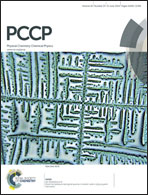Toward in silico modeling of palladium–hydrogen–carbon nanohorn nanocomposites†
Abstract
We present the first in silico modeling of the Pd–H-single-walled carbon nanohorn nanocomposites. Temperature-quench Monte Carlo simulations are used to generate the most stable morphologies of Pd81 clusters (cluster sizes of ∼2 nm) deposited inside the morphologically defective single-walled carbon nanohorns (S. Furmaniak, A. P. Terzyk, K. Kaneko, P. A. Gauden, P. Kowalczyk, T. Itoh, Phys. Chem. Chem. Phys., 2013, 15, 1232–1240). The optimized Pd81-single-walled carbon nanohorn nanocomposites are next used in calculating the H binding energy distributions at 300 K. The most stable positions of H impurity in confined Pd81 clusters are identified, showing subsurface character of H absorption from the dilute H2 gas at 300 K. The H binding energy distribution on the Pd(100) open surface at 300 K is computed and compared with those corresponding to Pd81–single-walled carbon nanohorn nanocomposites. Finally, the impact of the Pd–H short-range order on the H binding energy is explored and critically discussed.


 Please wait while we load your content...
Please wait while we load your content...